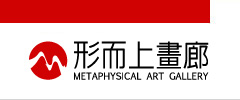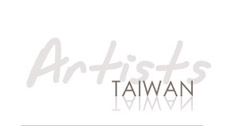Tao Wen-Yueh is an artist of enormous passions toward people and art, with a sincere, honest personality as well as considerate and sociable characters. His personality is reflected on his paintings in division by virtually the golden ratio, all the fragments interpreting his life experiences and his dreamland. His recent works even employ large-sized palette knives or broad brushes that make splendid turns to create mysterious cosmic images or ink tunes like loud sounds with hardly any word. There is never short of fabulous realistic shapes and imaginative colors in Tao’s works, as there are plenty of the tangible turned into symbolic signs. Lines and dots linger or discontinue in the frame as if to make visual interludes and extended melodies; simplified pictorial signs, on the other hand, allude to his merry memories or his belief in beauty.
It’s fair and appropriate to call Tao a player of shapes and colors, for he masters colors to manage other elements in the frame like partition ratio, shape formation, color contrast and placement, and the employment of cold and warm colors. And he is even better at grounding those simplified signs upon the colored facets seemingly afloat and constatnly popping up. Tao prepares a feast of colors from his palette; his recent works of a virtually Art Deco style do give some tension in visual language, style and manner, or slight poetry among his turning, smearing and scratching touches. Watching them again after a long while, I still find Tao’s works enduring. We discover the lineage of Taiwan’s modern abstractism in his placement and turn in large-scale colors; we also see the charming qualities he brings back from the French. Or as we may see his attempts to transcend the intellectuality and order in established partition ratios, aside from business in curating, teaching and art criticism, in some paintings Tao still appears to indulge in his pleasures with antiques. We also see his photographic works of everyday poetry, as he trails through the lanes in Taipei, each looking like a medieval sacred painting, radiating a feel of mesmerizing mystery.
Over the past couple years, Tao becomes fascinated in the appreciation and collection of tea bowls from Song China. He is specialized in the varieties and changes in the glaze, caused by the temperatures of firewood kiln in the process, on the black glazed Jian ware of the Fujian area, and he has grown quite experienced. For this reason, I am not surprised when Tao makes “temperature” the subject of his exhibition at Metaphysical Art Gallery. Color temperature is common knowledge to all photographers as it is essential to painting. All objects have intrinsic colors and ambient colors, and light source plays a significant part in making changes in hues, saturations and brightness according to various color temperatures. Also interesting is the stratosphere in astronomy, where the temperature issue is critical of global maintenance and human survival. Meanwhile, since the breakout of the coronavirus, people are measured their body temperature in all countries and regions in the world. We often said of a person of warmth as a person with affections; yet, at a time of disease like today, people are terrified of rising temperatures, be it of the weather or the human body. Does Tao’s latest exhibition “Soul to Soul” bring similar impacts to the audience? Could it be that the theme captures its time, that all are in need of warm emanation, no matter it’s the color temperatures on canvas or Tao’s sketch series “The Spirit”?
Tao’s newly finished works are a surprise to me. As a critic, I have read his journals, and I will attempt a discourse extended from his perspective. All the works have their own characters, each with particular creative foundation and context. Take the one drawing from Lao Tzu’s “Great semblance as shadow of a shade”. It’s Tao, in his middle age, taking a break from his busy career, reflecting on solitude and seeking inner peace. Tao makes abstract forms with flat brushes in yellow, orange and black colors, and he does so without any hesitation or break. Just as he states, abstract painting is spiritual quest and return to him. His mindset determines his art form, and it’s a creative approach of the contemporary time.
We see in “The Sound of Immensity” Tao’s attempt to approach the Oriental conception of a harmony between man and nature, a beauty of the mind that one is pleasant with all there is in the world. The particular touches and solid texture of this painting makes it look different from an ordinary ink painting; still, it expresses its own innocence with the vast highland and signs, that all in the frame comes from the symphony of mountains and waters. And “World of Symbol” reminds me of Tao’s everyday life; though commuting between Keelung, Taipei, Banqiao and rushing down the road, Tao may find a corner that moves him, compelling him to stop and take a picture. He often runs around the campuses of NTUA, NTUE and NTU as well as shows up in the museums, galleries and places like Yongkang, Lishui district also Showa Artifact Market. In those lanes of ages, Tao constantly takes pleasure in beauty in life and views it as a flâneur; such way of perception and life may come from his earlier, bourgeois days in Paris. Tao’s trainings in the École National Supérieur des Arts Décoratifs and the development of contemporary art certainly help in his art acculturation, too. They lead to the formation of liberal shapes and colors in his art; Tao also comes to sketch signs and symbols to construct his slightly decorative yet pure visual world. In his ordinary life, in all the street corners, Tao attends to shapes and colors, interprets the signs by ways of watching, and turns them into meaningful signs.
Since earlier days, as seen in “The Praise of Nature,” Tao focuses on the growth of plants and metaphorizes the hues, values, and chromas of color. In this painting, the warmth and passion of orange and the peaceful green, as contrast, are an ode to the life of plants and the witness to the secret origins of hope and strength. On the other hand, “The Island of Fantasy” comes from his life on the island, the sun and the sea. There’s also “The Abundant Journey ”, fantastically colorful like a mystery; it’s an imaginary space built together with mother earth and the sky, where lines and signs navigate within. It’s a work inspired by an egg-shell tea bowl from Song China that looks like a UFO; Tao recently acquired it, imagined himself driving this spaceship and drifting that ends up accomplishing this painting. As for “The Sound of Tranquilness”, whose employment of the red color perfectly speaks Tao’s passionate personality; its Oriental treatment of red with gold reflects Tao’s efforts to transform realistic subjects. Other than that, Tao explores further into the dynamics of object and space, founding his works on the contrast of points, lines, dimensions and colors, followed by—and covered or entertwined with—spontaneous lines and shapes, leading to visual cadence and appeal in space. Or, as in “The Legend from the Ancient Past,” Tao wonders the mystery of the birth of the universe that he portrays the the state of chaos, from nothing to being, an unsolved mystery that compels him to instill the imagination of such far past.
Tao’s obsession in colors seems to suggest he is a fanatic in botanical gardens. But “Green Trace” shows Tao’s favors in the therapeutic effects of green that, in the nature he loves with such passions, the vastness of the ocean and the extensive mountains soothes and relaxes him. This painting returns to his abstractist ideas and is an highly organic work of well structured textures. There’s also “The Infinite of Infinity,” the discovery of profound, mysterious galaxy from black glazed tea bowls of Song China; it’s mystical, made with boundless and profound concepts, bringing forth a fascination of the infinity of the universe. Tao’s ten sketches named after the series “The Spirit” stand from his oil paintings with full of the beauty of the lines combined with human’s physical structure; they display the beauty of the mixture of reality and imagination into two-dimensional space.
As a collector Tao is hopeless. He’s into buddhist statues, folk art, Taoist artifact, documents and files; he’s also a treasure hunter in flea markets and used bookstores; moreover, he’s a pioneer in curating and critiquing for young artists. He roams and strolls between clear and obscure tracks of time, flows of light and shadow; at times he may appear in a rush, absorbing the remnants of time, observing light, the dialogue between shapes and lanes of a backyard, and the alone texture of a deserted object. Tao collects them like a kind poet of time, who also enjoys taking pictures as he pleases, and his painting would emerge like light composing on photographs. Hence, Tao’s paintings are seldom dark or grey, as his memories tend not to concern changes over time; there’s neither sorrow, obscurity, nor bewilderment.
All in all, there’s warmth in Tao Wen-Yueh’s art. The partition of space, the touches, the textures and the colors on Tao’s frames particularly bring to mind his passion in antiques. Tao the collector has such impact on Tao the painter, that the antiques he collects are transformed into his paintings in their enigmatic aura, their somehow worn conditions and their insights, all through the long journey of time and space. And Tao’s attachment to the antiques and folk art is not reflected in their material look but in colors, as we see him rarely engage in realist styles except for his younger times, before he traveled abroad, when Tao used to be influenced by Taiwan’s hsiang-tu realism and made a few paintings of the sort. Today he becomes more of a eulogist of the shapes and colors in ordinary life. From his youth to the present day; from realistic, nostalgic formation inspired by hsiang-tu literature, semiotic sketches in personal journals, amazing experimental sketches at R.O.C.’s International Biennial Print Exhibition, to moving back and teaching. Today Tao’s art grows into a vocabulary of abstract signs, and his efforts deserve cheers and applauses.
|
|








